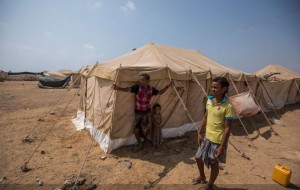Reverse exodus sees Yemenis seek safety in the Horn of Africa
In an extraordinary reversal of an exodus that has seen hundreds of thousands of Somalis risk death at sea to flee their war-torn homeland to seek refuge in Yemen, thousands of Yemenis are now fleeing from their own strife-riven country to Djibouti, Somalia’s neighbour.
As fighting intensifies in Yemen, more than 120,000 refugees and migrants have fled since April, with more than 15,000 seeking safety in Djibouti, according to the United Nations High Commissioner for Refugees (UNHCR).
Although these numbers pale in comparison to the refugees who have fled Africa to Yemen – last month UNHCR reported that there were some 265,000 there – they are still significant in Djibouti, whose total population is just 820,000.
“We have many refugees who recently arrived to the camp, and we can see from their faces and whenever we talk to them that they are traumatized,” said Abdul Rahman Mnawar, community services officer at Markazi camp where the UNHCR is providing aid.
“They have been through a lot during their flight,” he added, stressing that one of the most urgent issues is providing counselling and emotional support, especially to those who witnessed violence and killings firsthand,” Mr Mnawar.
The Yemeni Civil War is an ongoing conflict that began in 2015 between two factions claiming to constitute the Yemeni government, along with their supporters and allies.
Southern separatists – the largest numerical force – and forces loyal to the government of Abd Rabbuh Mansur Hadi, based in Aden, have clashed with Houthi forces and forces loyal to the former president Ali Abdulah Saleh.
There are suggestions that Al-Qaeda in the Arabian Peninsula (AQAP) and ISIS have also carried out attacks, with AQAP controlling swaths of territory in the hinterlands, and along stretches of the coast.
In March, the Houthi-led Shia-dominated Supreme Revolutionary Committee government declared a general mobilization to overthrow Hadi and further their control by driving into southern provinces.
The Houthi offensive took the city of Lahij and they reached the outskirts of Aden, sparking a coalition led by Saudi Arabia to launch military operations and air strikes to restore the former Yemeni government with the US providing intelligence and logistical support for the campaign.
The violence in Yemen has not stopped Somalis from still seeing it as a refuge from their own violence-torn country. UNHCR reported last month that 70,000 refugees, asylum-seekers and migrants crossed over to the country.
The sea route across the Gulf of Aden is extremely dangerous with 88 deaths recorded so far this year. The crews of the people-smuggling boats also frequently brutalize the passengers.
According to the UNHCR, the exodus to Yemen has shifted eastwards from the Gulf of Aden to the Arabian Sea coast where people believe the situation is calmer, resulting in over 10,000 new arrivals in September, a 50 per cent increase on August, and over 10,000 in October.
In recent years Yemen has seen violent conflicts largely caused by underlying problems of unequal access to power and resources.
There have been six rounds of fighting between the state and the Houthis in the north; separatist unrest in the south; frequent attacks by AQAP; and power struggles between tribal and military factions.
For much of the 20th Century, Yemen existed as two separate countries – the Yemen Arab Republic (YAR) in the north and the People’s Democratic Republic of Yemen (PDRY) in the south.
In 1990, the countries chose to unify and create the Republic of Yemen. However, southerners soon began complaining of political and economic marginalisation by the government in Sanaa, and fought a civil war in 1994 in a failed attempt to reverse the unification.
Instability and large-scale displacement, as well as weak governance, corruption, resource depletion and poor infrastructure, have hindered development in the poorest country in the Middle East.
Unemployment, high food prices and limited social services mean more than 10 million Yemenis are believed to be food insecure.
Laurie Nowell
AMES Australia Senior Journalist













